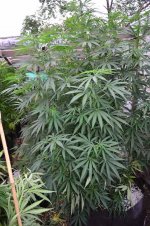B
BlueJayWay
I had heard a story about extreme gardening, something about it being the "baby" project of the son of a big horticultural company....
Look under a big tree, the soil should be held together by a semi solid white mass. That is mycorrhizal fungi. I would culture it the same way I would any other BIM. Odds are your culture will not be monoxenic, you will also likely get symbiotic bacteria. I have read putting the fungus in the worm bin make sure you eliminate any pathogens.On another note: does anyone add/inoculate with mycorrhizae? Every hydro store has a lot of very pricy jars of various brands, but I know there's gotta be a better way/source
Go to an area with a wild stand of similar grass species to what you are growing (untreated by humans) which has gone dormant; dig up some roots down to the newest growth; dry out and chop up the new growth area dirt n' all. Store until use. There should be local/indigenous endomycorrhizal spores galore which you can use to inoculate.
[when plants/grass goes dormant mycorrhizal is triggered to sporulate]
Darc Mind, when mentioning some landraces sats don't do well indoors, would that be the same reason why when I get heavily sativa leaning phenos, they yellow and drop fan leaves sooner whereas their indica leaning brethren are dark green & robust? Same soil/water/teas/lights et al. It's kind of fuckin' with my program LOL or maybe my situation is just simply - bigger plants, longer flowering = more food required, and they're not getting it since everything is catered to the short squat indies...
Yep - over 20' tall in the California desert hooked up to a Dosatron using Dyna Gro products - circa 1988.Remember, sativas keep growing their roots throughout flowering, indicas tend to slow down root growth after the stretch, so a sativa will need a lot more root space..
...and not limited to deserts either.....I have a type that can reach 20 ft take lows around 15 degrees and finish with nice frosty flowers outdoor @ 3000 ft at 49 N.Yep - over 20' tall in the California desert hooked up to a Dosatron using Dyna Gro products - circa 1988.
Of course that didn't stick out at all!
That's been my experience as well......expect the types that were African...or had African in them

View attachment 177525
Panama (pure sativa) from Cannabiogen. The plan was to keep it hidden inside this old barn type thingie that no longer has a roof. It has already grown through the roof...I am guessing almost 8 ft above the container right now. Bondage seems cruel...but some kinda plan needs to be formulated. It has a lot a potential growing left in it.
edit...and you can see the issue with perlite...the stuff tends to rise to the surface rather than stay where I wanted it to.
edit dos...somewhere between 4-5000 ft of elevation
ive heard good things about cannabio work but never made a purchase my self
View Image
here's some Super Silver Haze worked by dynasty
& a NL#5 x haze that may look familiar to some
View Image
some true landrace sativa's imho really dont do well indoors under artificial light & confined containers...
Make your own free Bokashi starter.
January 6, 2010
Source: http://bokashicomposting.com/
Making your own bokashi starter culture in place of commercially available EM is incredibly easy. My goal from the start was to produce bokashi compost without the use of expensive EM, bran or fancy buckets. The most important component of the commercial EM in relation to bokashi is lactobacillus bacteria, the others are secondary (if at all necessary) and can be cultured in the bucket when conditions are favorable. I culture my own lactobacillus serum starting with a rice wash water solution. Making the serum is amazingly simple.
Step One:
I mix one part rice thoroughly with two parts water (1/2 a cup to one cup).
Mix thoroughly and vigorously.
Drain. The resulting water should be cloudy.
Place the rice water in a container with 50-75% head space allowing plenty of air to circulate.
Cover lightly (air should be able to move in and out of the container) and place in a cool dark spot for 5-8 days.
At the end of the wait the mixture should smell mildly sour.
Strain out any particles.
Step Two:
Put the finished rice water solution in a bigger container and add 10 parts milk (I use skim).
DO NOT seal tightly, the gases must be able to escape.
Allow 14 days for a complete ferment, most of the solids in the milk will float to the top revealing the yellowish serum.
Strain off the solids.
You now have purified lactobacillus serum.
I love beneficial micro-organisms. I prefer to culture my own, because it's super easy, they perform best in their indigenous environment, and best of all it cost pennies.
How to Cultivate Beneficial Indigenous Micro-Organisms
http://bocashi.files.wordpress.com/2010/01/indig-microorg.pdf
Lacto B
"One of the major workhorse beneficial indigenous microorganism used in natural farming is lacto bacilli" Gil Cardanang